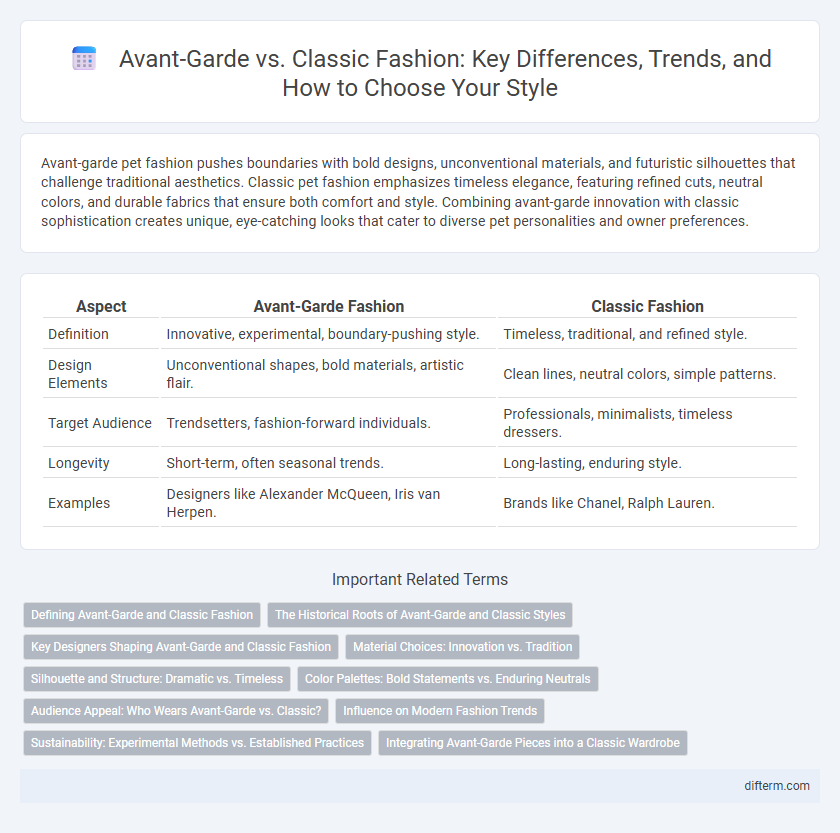Avant-garde pet fashion pushes boundaries with bold designs, unconventional materials, and futuristic silhouettes that challenge traditional aesthetics. Classic pet fashion emphasizes timeless elegance, featuring refined cuts, neutral colors, and durable fabrics that ensure both comfort and style. Combining avant-garde innovation with classic sophistication creates unique, eye-catching looks that cater to diverse pet personalities and owner preferences.
Table of Comparison
| Aspect | Avant-Garde Fashion | Classic Fashion |
|---|---|---|
| Definition | Innovative, experimental, boundary-pushing style. | Timeless, traditional, and refined style. |
| Design Elements | Unconventional shapes, bold materials, artistic flair. | Clean lines, neutral colors, simple patterns. |
| Target Audience | Trendsetters, fashion-forward individuals. | Professionals, minimalists, timeless dressers. |
| Longevity | Short-term, often seasonal trends. | Long-lasting, enduring style. |
| Examples | Designers like Alexander McQueen, Iris van Herpen. | Brands like Chanel, Ralph Lauren. |
Defining Avant-Garde and Classic Fashion
Avant-garde fashion challenges conventional aesthetics with innovative designs, unconventional materials, and bold silhouettes that push creative boundaries. Classic fashion emphasizes timeless elegance, characterized by minimalist cuts, neutral colors, and enduring styles that remain relevant across decades. Both styles represent distinct approaches: avant-garde as experimental art, and classic as enduring sophistication in the fashion industry.
The Historical Roots of Avant-Garde and Classic Styles
Avant-garde fashion traces its origins to early 20th-century art movements like Futurism and Dadaism, challenging traditional aesthetics with experimental designs and unconventional materials. Classic style, rooted in Victorian and Edwardian eras, emphasizes timeless elegance through structured silhouettes and refined tailoring. Understanding these historical foundations highlights the contrast between avant-garde's boundary-pushing innovation and classic fashion's enduring sophistication.
Key Designers Shaping Avant-Garde and Classic Fashion
Rei Kawakubo and Yohji Yamamoto are pioneering avant-garde fashion with their innovative, boundary-pushing designs that challenge traditional silhouettes and aesthetics. In contrast, designers like Ralph Lauren and Giorgio Armani continue to shape classic fashion through timeless elegance and refined tailoring that embody enduring sophistication. These key figures define their respective styles by balancing creativity and wearability, influencing global fashion trends and consumer preferences.
Material Choices: Innovation vs. Tradition
Avant-garde fashion embraces unconventional materials such as neoprene, metallic fabrics, and 3D-printed textiles, pushing boundaries with experimental textures and futuristic finishes. Classic fashion relies on traditional fabrics like wool, silk, and cotton, highlighting timeless quality, durability, and natural fibers. The contrast between innovative synthetics and heritage textiles defines the material dialogue between forward-thinking design and enduring elegance.
Silhouette and Structure: Dramatic vs. Timeless
Avant-garde fashion embraces dramatic silhouettes with bold, unconventional shapes that challenge traditional forms, often incorporating exaggerated proportions and unexpected structures. Classic fashion prioritizes timeless silhouettes characterized by clean lines, balanced proportions, and refined tailoring that enhance elegance and wearability. The contrast lies in avant-garde's experimental, sculptural approach versus classic's emphasis on enduring, harmonious design.
Color Palettes: Bold Statements vs. Enduring Neutrals
Avant-garde fashion embraces bold color palettes, featuring vibrant hues like electric blue, fiery red, and neon green to create striking visual statements that challenge conventional aesthetics. Classic fashion relies on enduring neutrals such as beige, navy, black, and ivory, offering timeless versatility that transcends seasonal trends. These contrasting color approaches define the essence of avant-garde's edgy creativity versus classic's refined elegance.
Audience Appeal: Who Wears Avant-Garde vs. Classic?
Avant-garde fashion attracts trendsetters and creative professionals who seek bold, experimental styles that challenge conventional aesthetics. Classic fashion appeals to a broader audience, including professionals and traditionalists, who prioritize timeless elegance and versatility. Understanding these distinct audience preferences helps brands tailor their designs to meet specific consumer desires and lifestyle needs.
Influence on Modern Fashion Trends
Avant-garde fashion challenges traditional aesthetics by introducing experimental silhouettes, bold textures, and unconventional materials, significantly influencing modern designers to push creative boundaries. Classic fashion's timeless elegance and structured tailoring remain foundational, inspiring a continual revival of refined, minimalist pieces in contemporary wardrobes. The dynamic interplay between avant-garde innovation and classic sophistication shapes evolving trends, driving the fusion of daring creativity with enduring style in today's fashion industry.
Sustainability: Experimental Methods vs. Established Practices
Avant-garde fashion embraces experimental methods such as biodegradable materials and zero-waste patterns, pushing sustainability boundaries through innovation. Classic fashion relies on established practices like natural fibers and timeless designs that promote durability and reduce consumption. Both approaches contribute to sustainability by merging creativity with environmental responsibility.
Integrating Avant-Garde Pieces into a Classic Wardrobe
Integrating avant-garde pieces into a classic wardrobe creates a striking balance between innovation and timeless style, elevating everyday outfits with bold shapes, unexpected textures, and artistic elements. Key strategies involve pairing statement avant-garde items like asymmetrical jackets or sculptural accessories with staple classics such as tailored trousers or crisp white shirts to maintain cohesion and sophistication. This fusion not only enhances personal style versatility but also reflects a fashion-forward mindset that respects tradition while embracing creativity.
avant-garde vs classic Infographic

 difterm.com
difterm.com